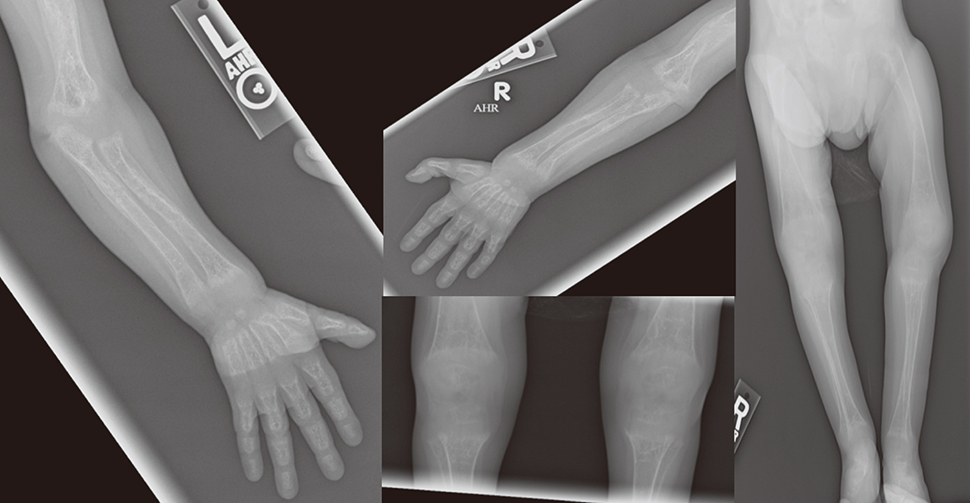J Bone Metab.
2017 Nov;24(4):257-261. 10.11005/jbm.2017.24.4.257.
X-linked Hypophosphatemic Rickets, del(2)(q37.1;q37.3) Deletion Syndrome and Mosaic Turner Syndrome, mos 45,X/46,X, del(2)(q37.1;q37.3) in a 3-year-old Female
- Affiliations
-
- 1Center for Endocrinology, Diabetes and Metabolism, Division of Endocrinology, Children's Hospital Los Angeles, Los Angeles, CA, USA. dpisit@chla.usc.edu
- 2Children's Hospital Los Angeles, Keck School of Medicine of University of Southern California, Los Angeles, CA, USA.
- KMID: 2397560
- DOI: http://doi.org/10.11005/jbm.2017.24.4.257
Abstract
- There are currently no published cases that report concomitant Turner syndrome (TS), 2q37 deletion syndrome and X-linked hypophosphatemic rickets (XLH). Interestingly, since the clinical phenotypes of TS and 2q37 deletion syndrome overlap, the correct diagnosis may be missed without a standardized approach to genetic testing consisting of both karyotype and microarray. Both chromosome anomalies have been associated with short stature and a variety of skeletal abnormalities however to date no reports have associated these syndromes in association with a phosphate regulating endopeptidase homolog, X-linked (PHEX) gene deletion resulting in XLH. We report a 3-year-old female with 3 concurrent genetic disorders including a 9.98 Mb terminal deletion of chromosome 2: del(2)(q37.1;q37.3), XLH secondary to a small microdeletion of part of the PHEX gene, and mosaic TS (mos 45,X[32]/46,X[18]). This is the first case report of a patient with 2q37 deletion syndrome and mosaic TS (mos 45,X[32]/46,X[18]) found to have XLH secondary to an interstitial constitutional PHEX gene deletion. Her severe phenotype and multiple genotypic findings reinforce the importance of thorough genetic testing in the setting of complicated phenotypic presentations.
MeSH Terms
Figure
Reference
-
1. Aldred MA, Sanford RO, Thomas NS, et al. Molecular analysis of 20 patients with 2q37.3 monosomy: definition of minimum deletion intervals for key phenotypes. J Med Genet. 2004; 41:433–439.
Article2. Tassano E, Buttgereit J, Bader M, et al. Genotype-phenotype correlation of 2q37 deletions including NPPC gene associated with skeletal malformations. PLoS One. 2013; 8:e66048.
Article3. Fernández-Rebollo E, Pérez O, Martinez-Bouzas C, et al. Two cases of deletion 2q37 associated with segregation of an unbalanced translocation 2;21: choanal atresia leading to misdiagnosis of CHARGE syndrome. Eur J Endocrinol. 2009; 160:711–717.
Article4. Cheon CK, Lee HS, Kim SY, et al. A novel de novo mutation within PHEX gene in a young girl with hypophosphatemic rickets and review of literature. Ann Pediatr Endocrinol Metab. 2014; 19:36–41.
Article5. Pavone V, Testa G, Gioitta Iachino S, et al. Hypophosphatemic rickets: etiology, clinical features and treatment. Eur J Orthop Surg Traumatol. 2015; 25:221–226.
Article6. Gaucher C, Walrant-Debray O, Nguyen TM, et al. PHEX analysis in 118 pedigrees reveals new genetic clues in hypophosphatemic rickets. Hum Genet. 2009; 125:401–411.
Article7. Li SS, Gu JM, Yu WJ, et al. Seven novel and six de novo PHEX gene mutations in patients with hypophosphatemic rickets. Int J Mol Med. 2016; 38:1703–1714.
Article8. Grossi A, Palma A, Zanni G, et al. Multiorgan autoimmunity in a Turner syndrome patient with partial monosomy 2q and trisomy 10p. Gene. 2013; 515:439–443.
Article
- Full Text Links
- Actions
-
Cited
- CITED
-
- Close
- Share
- Similar articles
-
- A Case of Prader-Willi Syndrome with an Unusually Large 15q Deletion Due to an Unbalanced Translocation to Chromosome 2 45,XX,-15, der(2) t(2;15)(q37:q13)
- Chromosome abnormalities in a referred population for suspected chromosomal aberrations: a report of 4117 cases
- A Case of mos 45,X/46,X, +mar. ish der(X)(wcpX+) Turner Syndrome
- Correlation between Karyotype and Phenotype in Turner Syndrome
- A Case of Variants of Turner syndrome Showing 46,X,inv(Y)/45,X Karyotype with Y Chromosome microdeletion


